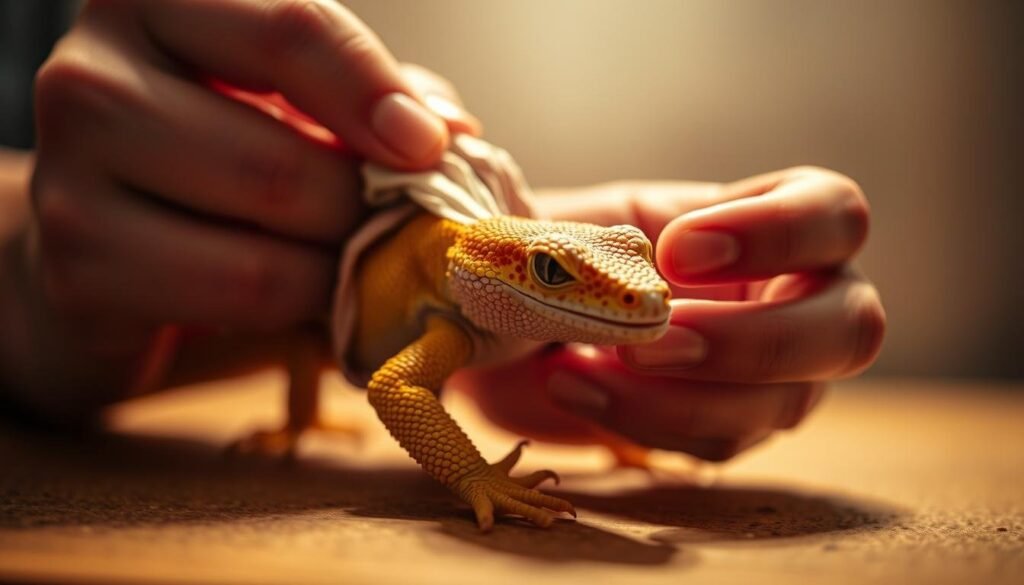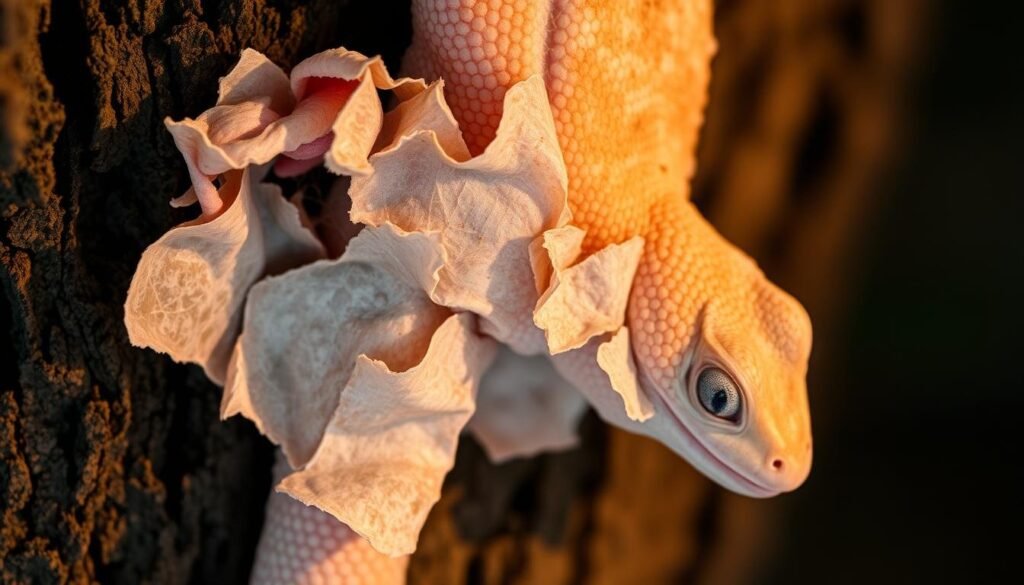Why Geckos Shed Skin Periodically for Growth? As a gecko owner, knowing about the gecko shedding process is key. Geckos shed their skin as they grow, a process that’s both interesting and necessary for them.
The skin-shedding process, or ecdysis, lets geckos get rid of old skin for new, healthy one. It’s crucial for their health and happiness. Learning about gecko skin shedding helps you keep an eye on your gecko’s health and spot problems early.
Looking after your gecko’s shedding can greatly improve their life. In the next parts, we’ll explore more about gecko shedding. This will give you a full understanding of this important part of caring for your gecko.
Contents
- 1 The Biological Process of Gecko Shedding
- 2 Why Do Geckos Shed Skin Periodically for Growth?
- 3 Signs Your Gecko is About to Shed
- 4 Supporting Your Gecko Through the Shedding Process
- 5 Common Shedding Problems and Solutions
- 6 Conclusion: Why Geckos Shed Skin Periodically for Growth?
- 7 FAQ
- 7.1 How often do geckos shed their skin?
- 7.2 What are the signs that my gecko is about to shed?
- 7.3 How can I support my gecko during the shedding process?
- 7.4 What are common shedding problems in geckos?
- 7.5 How can I help my gecko with stuck shed around its eyes or toes?
- 7.6 Is it normal for geckos to eat their shed skin?
- 7.7 Can I help my gecko shed by manually removing the skin?
The Biological Process of Gecko Shedding
Geckos shed their skin as they grow. Their skin doesn’t grow with them. So, they shed to fit their new size.
Before shedding, geckos show signs. They might look dull, be less active, or hide more.
- Dull skin color
- Reduced activity
- Increased hiding behavior
Their body starts to loosen the skin. This gets ready for shedding.
Active Shedding Phase
In the active shedding phase, geckos do a few things. They rub against things to loosen their skin. Then, they use their mouth to pull off the old skin.
This process happens fast. It’s important to keep their environment humid. This helps them shed smoothly.
Age-Related Shedding Frequency
Shedding changes with age. Young geckos shed more because they grow fast. As they get older, they shed less. [Why Geckos Shed Skin Periodically for Growth?]
For example:
| Age Group | Shedding Frequency |
|---|---|
| Juvenile (0-6 months) | Every 1-2 weeks |
| Sub-adult (6-12 months) | Every 2-4 weeks |
| Adult | Every 4-6 weeks |
Species Differences in Shedding Patterns
Shedding patterns vary by species. Some, like the Crested Gecko, shed in big pieces. Others, like the Gargoyle Gecko, shed in small pieces.
Knowing these differences helps in caring for them during shedding. [Why Geckos Shed Skin Periodically for Growth?]
Why Do Geckos Shed Skin Periodically for Growth?
Geckos shed their skin as they grow, a process vital for their health. Shedding, or ecdysis, is a natural part of their life. It lets them replace old skin with new, helping them grow and stay healthy.
Geckos shed their skin because it doesn’t grow with them. Unlike some animals, their skin stays the same size. They need to shed to keep growing without being limited by their old skin.
The importance of shedding is huge. It’s not just for growth. Shedding also helps geckos get rid of parasites and damaged skin, boosting their health. Plus, it shows a gecko is healthy. If a gecko can’t shed right, it might have a health problem.
In short, geckos shed to grow, stay healthy, and get rid of parasites or damaged skin. Knowing this helps you care for your gecko properly. It ensures they stay healthy and happy.
Signs Your Gecko is About to Shed
Knowing when your gecko is about to shed is key to caring for it. As shedding time nears, your gecko will show certain physical signs. These signs tell you that a shed is coming.
Dulling and Whitening of Skin
One clear sign is when your gecko’s skin dulls and whitens. This happens as new skin grows under the old. The outer skin then loses its color and looks cloudy or white.
Another sign is changes in your gecko’s eyes. They might look cloudy or milky as shedding starts. This is normal and usually means nothing unless other illness signs appear.
Knowing these signs helps you support your gecko during shedding. This ensures it stays healthy and happy. [Why Geckos Shed Skin Periodically for Growth?]
Supporting Your Gecko Through the Shedding Process
The shedding process can be tough for geckos. But, with the right care, you can make it easier. It’s important to create a good environment for your gecko.
Moist Hides and Shedding Boxes
One great way to help your gecko is by giving them moist hides or shedding boxes. These special enclosures keep the air moist. This helps soften the gecko’s skin, making shedding easier.
To make a moist hide, use a small container with damp sphagnum moss. Make sure it’s well-ventilated to avoid mold. [Why Geckos Shed Skin Periodically for Growth?]
| Component | Description | Benefits |
|---|---|---|
| Sphagnum Moss | Damp substrate used in moist hides | Maintains humidity, softens gecko skin |
| Small Container | Used to create a moist hide | Easy to place in the gecko’s enclosure |
| Ventilation | Essential for preventing mold growth | Ensures a healthy environment |
Textured Surfaces for Assistance
Moist hides aren’t the only help. Textured surfaces are also key. They let the gecko rub off its old skin. [Why Geckos Shed Skin Periodically for Growth?]
Add different textures like rough bark or rocks to the enclosure. This lets your gecko find the best surface for shedding.

By adding these elements to your gecko’s care, you can lessen shedding stress. This makes for a healthier, happier pet. [Why Geckos Shed Skin Periodically for Growth?]
Common Shedding Problems and Solutions
Geckos can face shedding problems that need attention from their owners. They shed their skin, but it can be hard, especially in sensitive areas.
Toes and Tail Tips
Shedding around toes and tail tips is a common issue. If the skin doesn’t come off, it can cause problems like constriction or infection. Keeping the enclosure humid helps. You can also mist your gecko with water to help shed the skin.
Watching your gecko’s shedding closely is important. If skin stays on toes or tail, use damp tweezers to gently remove it. Be careful not to hurt your gecko. [Why Geckos Shed Skin Periodically for Growth?]
Eye Caps and Sensitive Areas
Geckos may have trouble shedding skin around their eyes, known as “eye caps.” This can lead to infection or vision problems. Applying reptile eye drops can help loosen the skin around their eyes.
Keeping a clean, humid environment helps with shedding issues in sensitive areas. Clean the enclosure often and provide hiding spots. This reduces stress and makes shedding easier.
Knowing how to handle common shedding problems can help your gecko shed safely. Regular checks and a clean environment are crucial to avoid many issues. [Why Geckos Shed Skin Periodically for Growth?]
Conclusion: Why Geckos Shed Skin Periodically for Growth?
As a gecko owner, knowing about shedding is key to great care. Shedding lets your pet grow and keep healthy skin. By spotting shedding signs and helping your gecko, you can avoid problems and keep them healthy.
Shedding in geckos is complex, affected by humidity, temperature, and food. By managing these and knowing when your gecko sheds, you create a comfy space for healthy shedding.
Good care for geckos means more than just knowing about shedding. It’s also about being ready for any issues. By following the tips in this article, you can help your gecko shed well and stay healthy. This way, you ensure your pet lives a long, happy life.
See Also: Why Do Squirrels Gather and Bury Nuts?
FAQ
How often do geckos shed their skin?
Geckos shed their skin at different times. It depends on their age, species, and how fast they grow. Young geckos usually shed more than adults.
What are the signs that my gecko is about to shed?
Watch for dull and whitening skin. Also, look for cloudy or milky eyes. [Why Geckos Shed Skin Periodically for Growth?]
How can I support my gecko during the shedding process?
Make sure they have a moist hide or shedding box. Adding textured surfaces can also help.
What are common shedding problems in geckos?
Geckos often struggle to shed around their toes, tail tips, and eyes. Keep the humidity right and provide a good environment.
How can I help my gecko with stuck shed around its eyes or toes?
Raise the humidity in their home. Gently mist them with water. A shallow water dish for soaking can also help. [Why Geckos Shed Skin Periodically for Growth?]
Is it normal for geckos to eat their shed skin?
Yes, it’s normal for geckos to eat their shed skin. It’s a natural way for them to recycle nutrients and stay healthy.
Can I help my gecko shed by manually removing the skin?
No, don’t try to remove their shed skin yourself. It can hurt or stress them. Instead, create a good environment for easy shedding.

Zyair Larson, based in Denver, Colorado, has over 12 years of experience studying animal behavior. He has worked with the World Wildlife Fund (WWF) and National Geographic, researching wildlife and sharing insights on animal habits globally.

